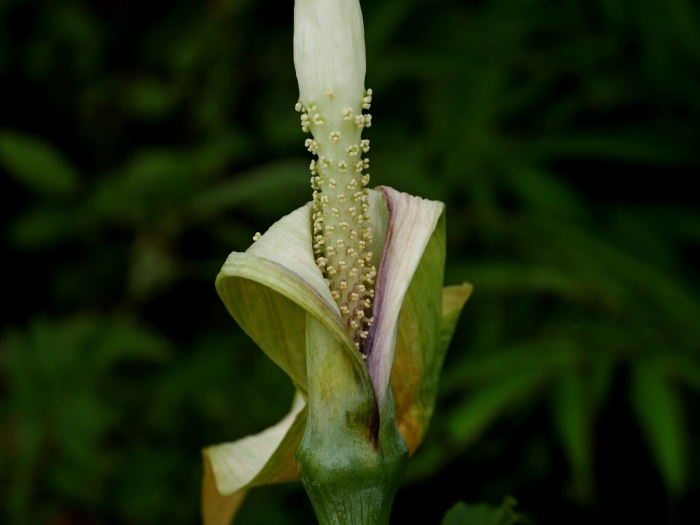Dancing Crane Cobra Lily
(Arisaema heterophyllum)
Dancing Crane Cobra Lily (Arisaema heterophyllum)
/
/

Jacy Chen
CC BY 4.0
Image By:
Jacy Chen
Recorded By:
Copyright:
CC BY 4.0
Copyright Notice:
Photo by: Jacy Chen | License Type: CC BY 4.0 | License URL: http://creativecommons.org/licenses/by/4.0/ | Rights Holder: Jacy Chen | Publisher: iNaturalist | Date Created: 2018-06-07T10:57:40-07:00 |

























Estimated Native Range
Summary
Arisaema heterophyllum, commonly known as the dancing crane cobra lily, is a perennial herb native to the understory of deciduous and mixed forests, as well as shaded areas along streams and in mountainous regions of East Asia, including China, Taiwan, Japan, Korea, and Inner Mongolia. It typically grows to a height of 20-60 cm and features a distinctive spadix inflorescence surrounded by a large, green, hood-like spathe that resembles a cobra’s head. The flowering season extends from April to June, with the flowers being more interesting than showy. Following the flowering period, the plant produces cylindrical red berries that are attractive but should not be consumed as they are poisonous.
The dancing crane cobra lily is valued for its unique and exotic appearance, which adds a dramatic touch to shade gardens and woodland plantings. It is also used in traditional Chinese medicine. In cultivation, it requires consistently moist, humus-rich, well-draining soil and thrives in part shade to full shade conditions. It is relatively low maintenance but should be protected from strong winds and direct sunlight. While not commonly used in urban planting, it can be a fascinating addition to botanical collections and gardens with a focus on Asian plant species.CC BY-SA 4.0
The dancing crane cobra lily is valued for its unique and exotic appearance, which adds a dramatic touch to shade gardens and woodland plantings. It is also used in traditional Chinese medicine. In cultivation, it requires consistently moist, humus-rich, well-draining soil and thrives in part shade to full shade conditions. It is relatively low maintenance but should be protected from strong winds and direct sunlight. While not commonly used in urban planting, it can be a fascinating addition to botanical collections and gardens with a focus on Asian plant species.CC BY-SA 4.0
Plant Description
- Plant Type: Herb, Bulb
- Height: 2-4 feet
- Width: 0.6-1 feet
- Growth Rate: Moderate
- Flower Color: Green
- Flowering Season: Spring, Summer
- Leaf Retention: Deciduous
Growth Requirements
- Sun: Part Shade, Full Shade
- Water: Medium
- Drainage: Medium
Common Uses
Bee Garden, Border Plant, Low Maintenance, Potted Plant
Natural Habitat
native to the understory of deciduous and mixed forests, as well as shaded areas along streams and in mountainous regions of East Asia, including China, Taiwan, Japan, Korea, and Inner Mongolia
Other Names
Common Names: Broad-leaved Arisaema
Scientific Names: , Arisaema heterophyllum, Arisaema ambiguum, Arisaema brachyspathum, Arisaema heterophyllum subsp. nigropunctatum, Arisaema heterophyllum subsp. typicum, Arisaema heterophyllum var. nigropunctatum, Arisaema heterophyllum var. typicum, Arisaema koreanum, Arisaema koreanum subsp. tacquetii
GBIF Accepted Name: